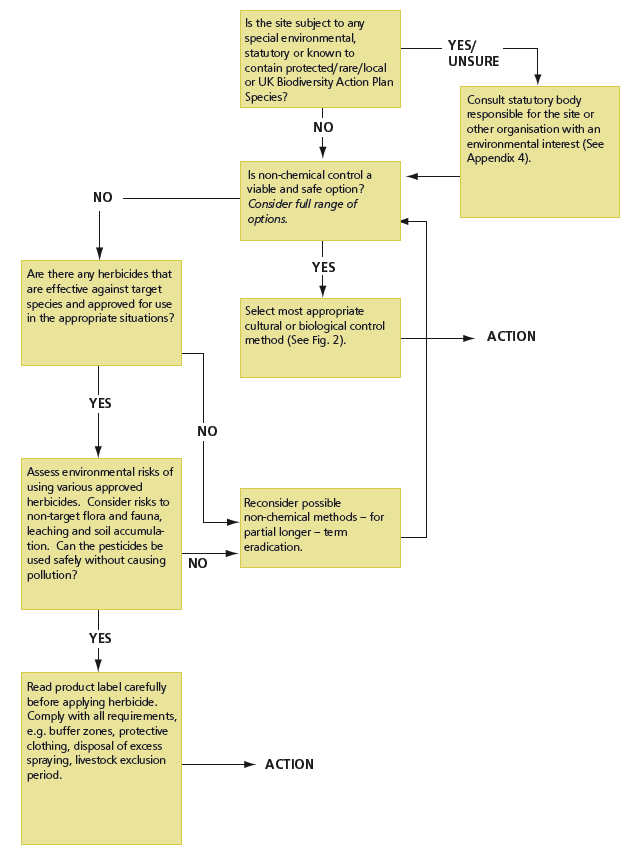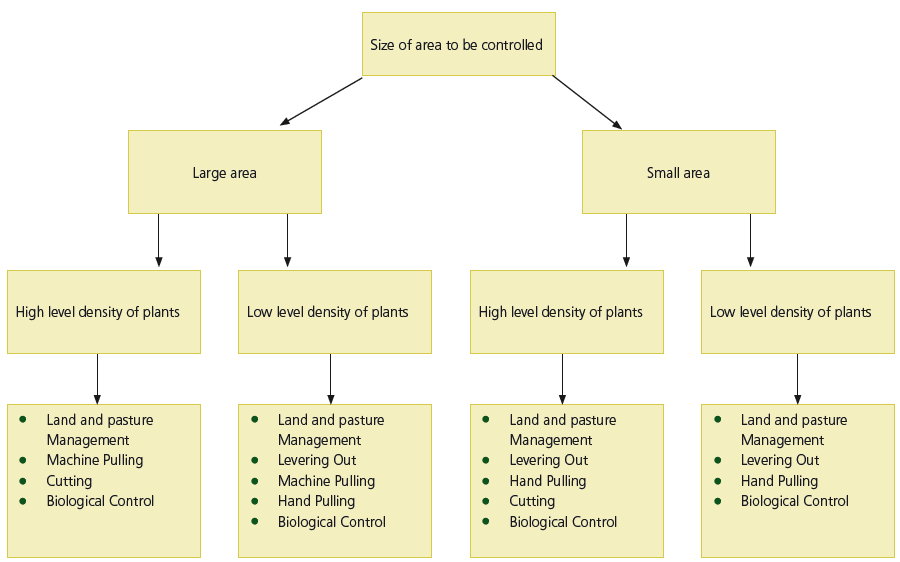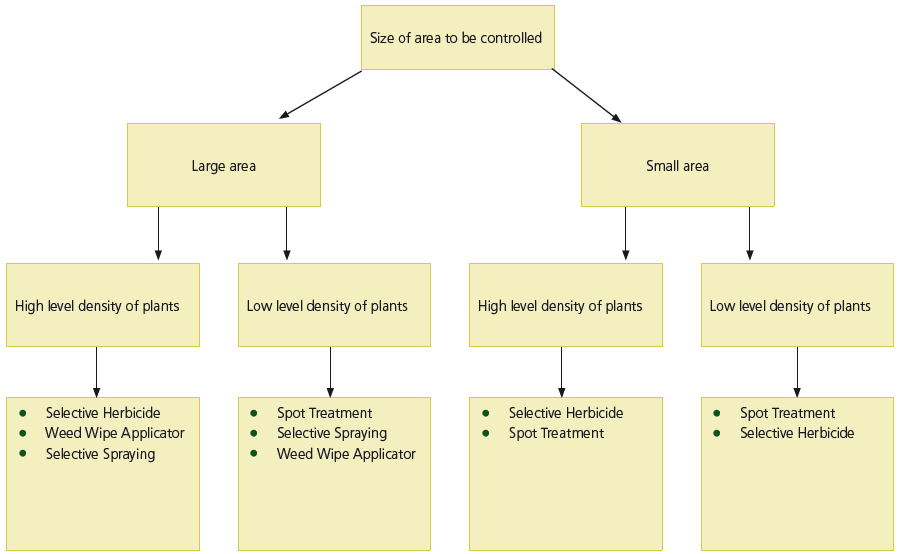How to prevent the spread of ragwort: guidance
The guide offers advice to prevent and control the spread of ragwort where there is a threat to the health and welfare of animals.
Appendix 3: control techniques
Introduction
1 Where the risk that ragwort will spread is such that control action is required or where ragwort is present on grazing land/land used for the preparation of conserved forage, three primary control methods are available:
- cultural
- chemical
- biological
Each method can be employed in a number of ways depending on the location, the population density, and the extent of control required. In many cases effective control will only be possible if a combination of methods is employed. Repeat treatment over several seasons might also be required to deal with long established populations of ragwort.
2 The decision tree in Figure 1 will assist with selecting the most appropriate method of control.
3 On managed grassland or other pasture, land management techniques have an important role to play in controlling the spread of ragwort by preventing its establishment (see appendix 1).
4 All grazing animals are susceptible to the toxic effects of ragwort and therefore the deliberate control of ragwort by grazing horses, sheep, goats or other livestock must not be undertaken.
Cultural control techniques
5 Several cultural methods can be used to prevent the spread of ragwort including the general avoidance of bare ground areas, pulling/levering, cutting, and the use of burners. Figure 2 will assist with selecting the most appropriate method of cultural control.
Figure 1. Decision tree to assist selecting the most appropriate control method

Figure 2. Selecting the most appropriate cultural and biological control according to size of area and level of density of plants

Avoiding bare ground
6 Bare ground areas resulting from heavy poaching and/or overstocking are to be avoided where at all possible. This can be achieved by removing animals from ground to prevent poaching (i.e. churning up of land by animals) of land in wet weather conditions, particularly December to March, and by avoiding over grazing of land at other times. Control of rabbit populations may also be necessary to maintain ground cover.
Pulling and levering
7 Pulling or levering up plants can prevent seed spread and can give long-term control, although any root fragments not removed can produce weak growth. Hand pulling is appropriate for smaller areas but for larger areas the use of machine pulling should be considered. Machine pulling requires a height difference between the ragwort and other plants and is only suitable on certain soil types and topographies. Various hand tools are available for levering. Best results are achieved when the soil is damp and before ragwort has seeded.
8 Ragwort is an injurious weed and consequently all operatives involved in handling the plant must have received the appropriate instruction for the task and must be supplied with the appropriate type of personal protective equipment (see appendix 6).
9 A combination of manual/mechanical pulling or levering and reducing disturbance to soil can be effective against ragwort if repeated over a number of years, without having to resort to herbicide use. Ragwort which has been either manually or mechanically pulled or levered should be disposed of safely (see appendix 5) to prevent re-seeding.
Cutting
10 Cutting is a control method of last resort and should only be used to reduce seed production and dispersal where other more effective control methods cannot be used. Cutting stimulates growth and plants subsequently re-flower later in the season. Cutting and stem removal at the early flowering stage reduces seed production but does not destroy the plant, turning it from a biennial into a perennial habit and therefore repeat treatments will be required to prevent the ragwort from seeding.
11 Cut plants left lying in the field are a serious risk to grazing animals, as they remain toxic, are more likely to be eaten, and may still set seed. Plants must be removed and safely disposed of (see appendix 5) before returning grazing animals to the field.
Burners
12 Spot burners (hand held flame guns) can be used at rosette stage. Success can be variable; ranging from 93% kill of ragwort seeding plants to rapid re-growth occurring. Consideration will need to be given to the potential damage that might be done to surrounding vegetation and the risks of fire. Operator safety will also need to be considered carefully. In most circumstances the use of spot burners is unlikely to be suitable except on hard surfaces and paved areas.
13 Where the use of spot burners is a preferred method of control, a suitable and sufficient risk assessment must be undertaken prior to use.
Chemical control techniques
Use of herbicides
14 Herbicides must only be used after a risk assessment has been completed. This must include consideration of any potential effects on the environment and on human and animal health. Where a herbicide cannot be used safely an alternative control method should be used. Risk assessments should also consider the likely ecological impacts of taking no action, which can sometimes outweigh any negative effects of a herbicide treatment. Widespread spraying with herbicide is not recommended. Use of herbicide should be a last resort and carefully targeted.
15 Herbicides can be a time-efficient and effective method of preventing the spread of ragwort. Total control cannot be guaranteed with one application. However, an annual chemical control programme will generally prevent the spread of ragwort.
16 Only herbicides and uses approved under the Control of Pesticides Regulations 1986 (as amended) or the Plant Protection Products (Scotland) Regulations 2005 (as amended) can legally be sold, supplied, stored, advertised and used. Current lists of approved products can be found on the Pesticide Safety Directorate (PSD) website. All herbicides must have an appropriate standard or 'off-label' approval for use in a relevant situation. It is important to keep records of any herbicide used.
17 Always read the product label before using a herbicide and comply with all statutory conditions. Where a herbicide is to be applied under the terms of an off-label approval, users must obtain and read the relevant Notice of Approval (published by the Pesticides Safety Directorate). Users should be aware that pesticides used under an off label approval are done so at the user's own risk and may not be as effective.
18 Because herbicides are not equally effective at all stages of plant growth, repeated treatments at different times of year are recommended for optimum control. However, the time of year that a herbicide is applied might be constrained by legal requirements stipulated on the product label. Decisions should take into account the efficacy of the herbicide against the target species (e.g. many herbicides are more effective when applied to actively growing weeds) and any probable impacts of different timings on other
non-target species at that site.
19 In deciding which chemical to use, it will be helpful to refer to the Environmental Information sheets that are being produced for all pesticide products under the Voluntary Initiative, a programme of measures agreed by the pesticide industry with Government to minimise the environmental impact of pesticides. Further details can be found on the Voluntary Initiative website.
Legal restrictions
20 The advertisement, sale, supply and use of agricultural pesticides are regulated by Part III of the Food and Environment Protection Act 1985, the Control of Pesticides Regulations 1986 (as amended), the Plant Protection Products (Basic Conditions) Regulations 1997, and the Health and Safety at Work Etc Act 1974. These are supplemented by two statutory codes: the Code of Practice for using Plant Protection Products in Scotland and the Code of Practice for Suppliers of Pesticides to Agriculture, Horticulture and Forestry.
21 The Control of Substances Hazardous to Health (COSHH) Regulations 2002 require that pesticides (including herbicides) should only be used where necessary, and where the benefits significantly outweigh the risks to human health and the environment. Non-chemical control options must therefore be considered and herbicides should only be used in situations where alternatives do not exist, or are impractical or likely to be inadequate.
Training and certification of spray operators
22 Spraying should only be carried out by a competent person who is suitably trained and qualified; and in accordance with the pesticides and health and safety legislation. No person who was born later than 31 December 1964 can use a pesticide approved for agricultural use - unless that person has obtained a recognised Certificate of Competence. Irrespective of their age, all persons who use pesticides as part of a commercial service (i.e. as a contractor on land not in the ownership or occupation of the contractor) must hold a Certificate of Competence, or work under the direct personal supervision of a person who holds such a certificate. Surplus chemicals must be disposed of according to the Code of Practice for using Plant Protection Products and the legislation in force in Scotland.
Restrictions on use of pesticides in or near water
23 Regulations made under the Food and Environment Protection Act 1985 control the use of herbicides/pesticides where pollution of water might occur. Further guidance on preventing contamination of surface water and groundwater can be found in the Code of Practice for using Plant Protection Products in Scotland.
Livestock
24 Any period of time when animals need to be kept away from the treated area will be specified on the product label. Make sure you follow this instruction.
25 Some poisonous weeds, such as ragwort, can become more attractive to grazing animals after they have been treated with herbicides. It is important to keep horses and livestock out of treated areas until the weeds have died and completely disappeared, whether or not the product label of the herbicide used says that livestock have to be kept off the land for a set period.
Environmental restrictions
26 The use of herbicides to control ragwort will affect other plant species within the treated area. Areas protected by legislation, e.g. SSSIs, Natura 2000 sites and agri-environment schemes, also restrict the use of certain chemicals and the relevant authority should be consulted prior to operations (see appendix 4).
Methods of application
27 Efficacy and environmental safety are directly affected by the method of application, which must comply with statutory requirements and the specific conditions of approval set for the pesticide concerned. Effective targeting of herbicides is important, particularly when non-selective herbicides are used. Non-selective, translocated herbicides present the highest risk to non-target plants. The type of herbicide used and the method of application will be influenced by:
- the extent, distribution and location of the target species
- height and structure of the target species
- height, structure and sensitivity of surrounding/adjacent non-target species
- approval and label requirements
28 Weed-wipers provide a method for the targeted treatment of weeds that are taller (at least 10cm taller) than the associated non-target vegetation. Weed-wipers are available for different scales of operation: from small hand-held wipers to large tractor-mounted equipment.
29 The most widely used type of hand-held sprayer is the Knapsack Sprayer, which is suitable for spot-treatment of ragwort on small areas and on very rough or steep terrain. Sprayers mounted on tractors or ATVs may be more suitable for larger areas of relatively even ground but are, by their nature, more indiscriminate in coverage than hand-held sprayers and may not be appropriate for all situations.
Environmental safety
30 An evaluation of environmental risks is essential wherever herbicides/pesticides are used and should always consider both short and long-term, local and remote effects, impacts on animals as well as plants, and possible indirect effects (e.g. through destruction of nesting sites, deoxygenation of ponds caused by organisms decomposing, dead vegetation, etc.)
31 To minimise the effects of herbicides on non-target species:
- use a weed wiper or spot treatment wherever practicable
- spot treat, if possible, and use a guard on the sprayer lance to more effectively target sprays and reduce drift
- use a selective herbicide that is less damaging to non-target species
- leave an unsprayed buffer zone between treated and vulnerable species/habitats
- avoid fine sprays, use medium-coarse droplet nozzles
- keep spray nozzles as close as possible to target plants
- consider use of low drift nozzles
- avoid spraying in unsuitable weather, e.g. when wind speed is greater than Beaufort Force 2 or on very calm, warm days
32 Figure 3 will assist with selecting the most appropriate method of chemical control.
Figure 3. Decision tree to assist selecting the most appropriate herbicide treatment according to size of area and level of density of plants

Biological control techniques
33 Biological control is aimed at controlling ragwort by using the plant's natural enemies to lower its density, thereby suppressing ragwort populations and allowing other plants to re-establish. Many species feed on ragwort including; cinnabar moth (tyria jacobaea), ragwort flea beetle (longitarsus jacobaea) and ragwort seedfly (pegohylemia seneciella). High densities or "plague levels" of cinnabar moths in particular, can destroy complete ragwort populations. However the natural spread of these species might not always be as wide-ranging as that of ragwort. Other potential biological control agents include several fungal pathogens (rust diseases) but none of these significantly reduce ragwort populations.
34 The introduction of a biological control agent has a potential advantage in areas where chemical/mechanical control is unachievable or undesirable. However, it can be difficult to maintain sufficient predator populations to provide adequate control and may only result in a reduction rather than a control of spread. Biological control is therefore best used as part of a long-term strategy. Biological control by cinnabar moths is not suitable for the control of ragwort on grazing land or land used for forage production. Approval is required from Scottish Natural Heritage ( SNH) before this technique is used within SSSIs, Natura 2000 sites and other areas protected by environmental or ecological designation. For SSSI's, Natura 2000 Sites and other areas protected by environmental or ecological designation the local SNH Area office should be contacted for further information before this technique is used.
There is a problem
Thanks for your feedback